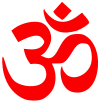
The Bhakti movement was a significant religious movement in medieval Hinduism that sought to bring religious reforms to all strata of society by adopting the method of devotion to achieve salvation. Originating in Tamilakam during 6th century CE, it gained prominence through the poems and teachings of the Vaishnava Alvars and Shaiva Nayanars before spreading northwards. It swept over east and north India from the 15th century onwards, reaching its zenith between the 15th and 17th century CE.
Bhakti yoga, also called Bhakti marga, is a spiritual path or spiritual practice within Hinduism focused on loving devotion towards any personal deity. It is one of the three classical paths in Hinduism which lead to moksha, the other paths being jnana yoga and karma yoga.

Sant Dnyaneshwar, also referred to as Dnyaneshwar, Dnyanadeva, Dnyandev or Mauli or Dnyaneshwar Vitthal Kulkarni (1275–1296), was a 13th-century Indian Marathi saint, poet, philosopher and yogi of the Nath and Varkari tradition. In his short life of 21 years, he authored Dnyaneshwari and Amrutanubhav. These are the oldest surviving literary works in the Marathi language, and considered to be milestones in Marathi literature. Sant Dnyaneshwar's ideas reflect the non-dualistic Advaita Vedanta philosophy and an emphasis on Yoga and bhakti towards Vithoba, an incarnation of Vishnu. His legacy inspired saint-poets such as Eknath and Tukaram, and he is one of the founders of the Varkari (Vithoba-Krishna) Bhakti movement tradition of Hinduism in Maharashtra. Dnyaneshwar undertook samadhi at Alandi in 1296 by entombing himself in an underground chamber.

Sant Tukaram Maharaj, also known as Tuka, Tukobaraya, Tukoba, was a Hindu, Marathi Saint of Varkari sampradaya" in Dehu village, Maharashtra in the 17th century. He was a bhakt of the god Vithoba of Pandharpur. He is best known for his devotional poetry called Abhanga, which are popular in Maharashtra, many of his poems deals with social reform.
Marathi literature is the body of literature of Marathi, an Indo-Aryan language spoken mainly in the Indian state of Maharashtra and written in the Devanagari and Modi script.

Karma yoga, also called Karma marga, is one of the three classical spiritual paths mentioned in the Bhagavad Gita, one based on the "yoga of action", the others being Jnana yoga and Bhakti yoga. To a karma yogi, right action is a form of prayer. The paths are not mutually exclusive in Hinduism, but the relative emphasis between Karma yoga, Jnana yoga and Bhakti yoga varies by the individual.

Warkari is a sampradaya within the bhakti spiritual tradition of Hinduism, geographically associated with the Indian state of Maharashtra. Warkaris worship Vitthal, the presiding deity of Pandharpur, regarded as a form of Vishnu. Saints and gurus of the bhakti movement associated with the Warkaris include Dnyaneshwar, Namdev, Chokhamela, Eknath, and Tukaram all of whom are accorded the title of Sant. Recent research has suggested that the Varkaris were historically the followers of Krishna. Vittala is also another name for Krishna. Krishna is referenced as Vittala in most Bhakthi songs of Purandara Dasa and other Bhakti Saints.
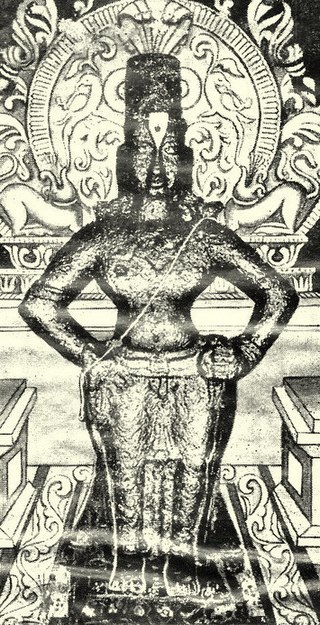
Vithoba, also known as Vitthala, and Panduranga, is a Hindu deity predominantly worshipped in the Indian state of Maharashtra and Karnataka. He is a form of the Hindu deity Vishnu in his avatar: Krishna. Vithoba is often depicted as a dark young boy, standing arms akimbo on a brick, sometimes accompanied by his consort Rakhumai.

Dhyāna in Hinduism means contemplation and meditation. Dhyana is taken up in Yoga practices, and is a means to samadhi and self-knowledge.

Goloka or Goloka Vrindavan is the celestial abode of the Hindu god Krishna and his chief consort Radha. In the Bhagavata Purana and Garga Samhita, Krishna is portrayed as the highest person who resides in Goloka along with his three wives - Radha, Virija and Bhudevi.
Marathi poetry is a poetry written in the Marathi language, including its various dialects.

The Bhagavad Gita, often referred to as the Gita, is a Hindu scripture, dated to the second or first century BCE, which forms part of the Epic Mahabharata. It is a synthesis of various strands of Indian religious thought, including the Vedic concept of dharma ; samkhya-based yoga and jnana ; and bhakti (devotion). It holds a unique pan-Hindu influence as the most prominent sacred text, and is a central text in Vedanta and the Vaishnava Hindu tradition.
Nivruttinath was a 13th-century Marathi Bhakti saint, poet, philosopher and yogi of the Vaishnava Nath tradition. He was the elder brother and the mentor (guru) of Dnyaneshwar, the first Varkari saint.
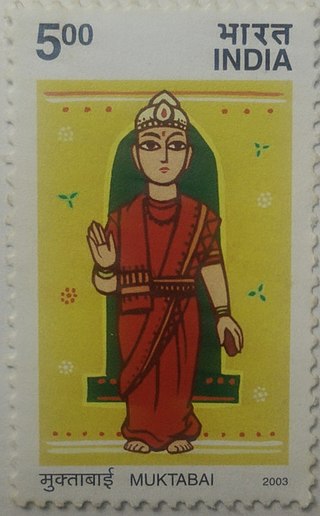
Muktabai or Mukta was a saint in the Varkari Movement. She was born in a Deshastha Brahmin family and was the younger sister of Dnyaneshwar, the first Varkari saint. She wrote forty-one abhangs throughout her life.

The Gītā Dhyānam, also called the Gītā Dhyāna or the Dhyāna Ślokas associated with the Gītā, is a 9-verse Sanskrit poem that has often been attached to the Bhagavad Gita, one of the most important scriptures of Hinduism. In English, its title can be translated literally as "meditation on the Gita," and it is also sometimes called the Invocation to the Gita.
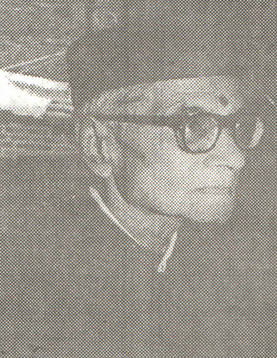
Bhalchandra Pandharinath Bahirat was a philosopher and educationist who studied the Marathi literature of Jñāneśvar and other sants of Maharashtra. He was awarded an honorary Doctor of Letters from Pune University in 1991.
Ovee, also spelled owi or owee, is a poetic metre used in Marathi poems for "rhythmic prose", generally used in narrative poems. A poem using this metre is also called an ovee. Ovee is one of the "oldest Marathi song genres still performed today". It has been in use since the 13th century in written poetry; however, oral traditions of women's ovee pre-date the literary ovee. While literary ovee is used by the Varkari saints in bhakti (devotional) literature, women's ovee is passed via the oral tradition through generations of women, who sing them while working or for pleasure.
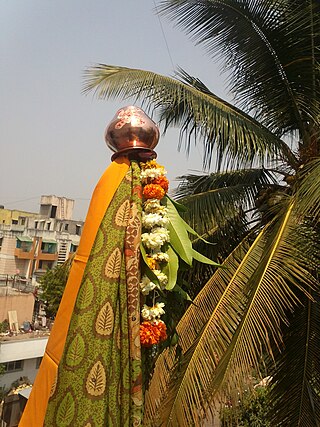
Hindus form 79.83% of the state's total population as per 2011 census. Hindus form the majority in all the districts of the state.The religion plays an important role in the lives of the Maharashtrian people in their day-to-day life. Vitthoba, along with other incarnations of Vishnu such as Rama and Krishna, Hanuman, Dattatreya, and Shaiva deities such as Shiva, Parvati, and Ganesha, are popular with Hindus of Maharashtra. The Varkari tradition holds a strong grip on the local Hindus of Maharashtra. The public Ganesha festival started by Bal Gangadhar Tilak in the late 19th century is very popular. Marathi Hindus also revere Bhakti saints associated with varkari sects such as Dnyaneshwar, Savata Mali, Tukaram, Namdev, Janabai, and Chokhamela. Many religious figures from 19th and 20th century are revered. They include Swami Samarth, Gajanan Maharaj, Sai baba of Shirdi, Tukdoji Maharaj, Gondavalekar Maharaj, and Gadge Maharaj.

